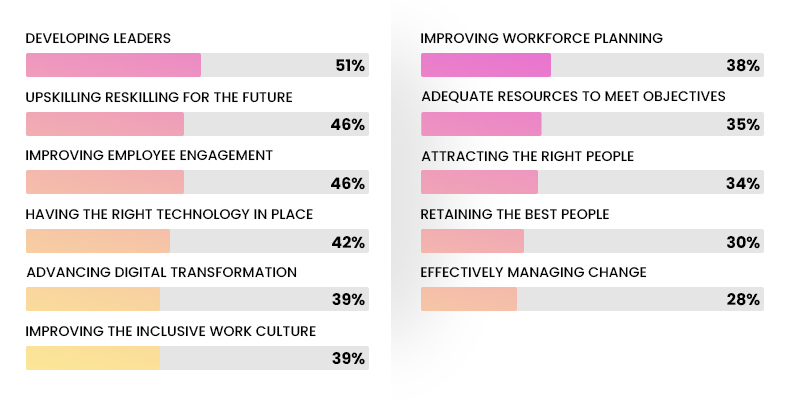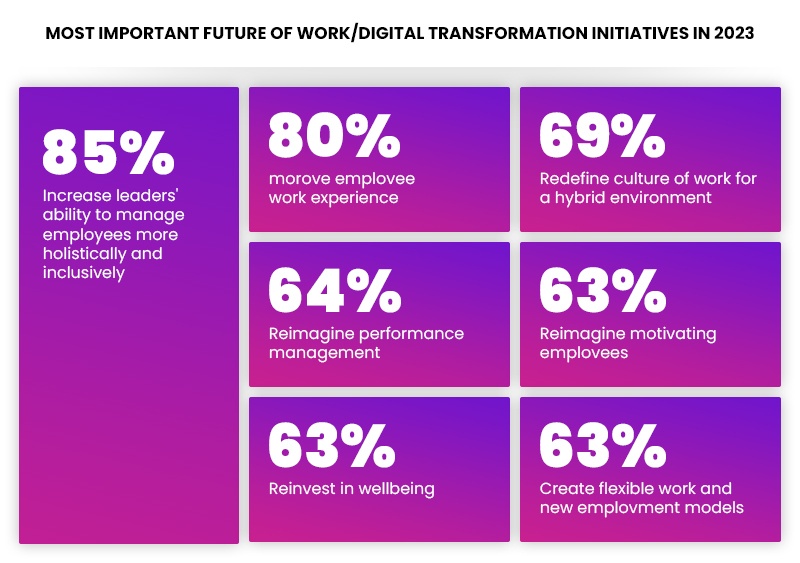Digital Learning Trends 2023
2022 witnessed a drastic change in the way businesses are going about conducting their activities. Organizations now require a different mindset and a different set of skills. They need to look at critical trends that will shape how they move forward.
The pandemic destroyed many paradigms. While there was a loss in business, new ways were invented to tackle the problems grappling the world. So, the skills that were relevant even a few years back may not work today. Organizations need to look at skills and talent to match those skills or to bring the talent to speed on the critical skills. They need to understand the new dynamics and the newer ways of learning. Technology will play a vital role in this transformation and act as a great enabler.
Thus, it starts from the top, that is, leadership. The most significant trend we need to watch out for is leadership training or realigning the leaders to the new reality, newer ways of working, and upgrading themselves with new skills.
Flexibility, employee well-being, skills over roles and jobs, demarcating soft and hard skills, getting HR closer to the business, sustainability, and transformation across the board will be key areas for 2023.
As a first step, we are providing our list of the top trends for the Learning and Development industry for 2023. While each trend will be an important marker, some would be more critical for organizational development than others:
- Leadership training and development
- Skill mapping, content curated to the right skill
- Targeted assessments for better learning curation
- Multiple training modalities for better learning outcomes
- Career mobility and progression with enhanced learning pathways
- Human-centered approach to learning
- Data security
- Learning powered by globalization
- Millennials and everyone else—learning will thrive
Let's look at these trends in brief.
1. Leadership Training And Development
Any idea why leadership training fails? Ever pondered asking why?
To ensure a stronger impact on individuals, an organization must clearly define roles, responsibilities, and relationships, both significant and otherwise. Another acceptance is that organizations not willing to change systems on leadership training are setting up people for failure.
According to a Pulse survey conducted by the Brandon Hall group, there are certain key aspects that organizations have identified as their top priorities.
Let's look at a few of them, starting with people issues.

Source: Brandon Hall Group, Human Capital Management (HCM) Outlook 2023, Research Data Highlights
Leadership development is a top priority of organizations. Strong leadership will drive organizations forward, and no wonder organizations are willing to go the extra mile to develop a leadership pipeline and do the necessary upskilling.
Always look at the following:
- Inspire a new direction
- Gather unthought-of observations
- Dive deeper into collaborative consultation
- Ensure behavioral change is backed by actionable outcomes
2. Skill Mapping, Content Curated To The Right Skill
From the previous graphic, we can note that upskilling and reskilling will be another key priority across the talent pool.
Newer skills and niches will become more relevant and important for success in the workplace. It is crucial that skill mapping is done correctly and that the right training content is identified for the skills. It is not just about the functional, domain, or technical skills in today's dynamic environment. It's also about micro-skills, as specialization takes center stage. There is a demand for people who are multiskilled and have skills in specialized areas. Thus, training content needs to be mapped correctly so that the learners benefit from it and apply it to their jobs.
As much as skills mapping is about an individual's strengths and weaknesses, it is also an easy way to understand how the organization benefits in totality. Get a collective outcome, starting with you, your organization, and your clients.
Content curated via skills mapping as the foundation of learning no more remains formal and episodic. The "Great Reshuffle" or "Great Resignation" are perfect examples for L&D to get a hold on the skills needed, to think differently, and to better align to business strategies and objectives.
3. Targeted Assessments For Better Learning Curation
A natural outcome of the thought of skill mapping is also providing the right kind of assessment. When the assessments are designed correctly and are provided in a targeted manner, meaning to the right target audience in the right dosage, it leads to many profitable outcomes. One of them is identifying the right learning strategies and content for the required skills. This will be an important trend, as many organizations look for curation as a solution to providing the right type of learning content for their employees.
Gather information about learners' knowledge, skills, and understanding to inform the trainer and content curator of assessing the outcome with content evolution in mind. Misconceptions can be avoided, which is one way to ensure the learner's relationship with the L&D teams also takes a positive shift.
4. Multiple Training Modalities For Better Learning Outcomes (Hybrid Learning)
If workplaces are becoming hybrid, can hybrid learning stay far behind? The answer is an obvious "no." Organizations are increasingly looking for hybrid learning as a viable solution for their learning needs. With a remote workforce, some people working from home, some working from anywhere, and still some others attending office, it is imperative that organizations have hybrid learning in place. This includes virtual instructor-led, classroom instructor-led, eLearning, microlearning, performance support, pre- and post-assessments, games, and much more. Learning strategists need to consider all these to make learning a holistic experience. Hybrid learning will be an important trend for the year 2023 and beyond.
Keep it simple through three questions you want to ask about the learning/training:
- When do you want to do this? This addresses the time aspect.
- Where do you want to do this? This addresses the space or location aspect.
- How do you want to do this? This addresses the interaction aspect.
What you are out to accomplish is a good training outcome, ensuring time is effectively used, all types of learners are accounted for, adaptability of the content, and more such aspects.
5. Career Mobility And Progression With Enhanced Learning Pathways
The year 2022 saw the Great Resignation as a force to be reckoned with. So, what will it take to retain key talent and help them grow simultaneously? The answer lies in learning tied to career progression. There must be a clear linkage between the learning pathways directly tied to better career progression. With the use of technology and platforms, organizations will leverage them for better and more focused learning that will help their employees have a better sense of upward career mobility and a clear sense of purpose and direction. This is directly linked to the second trend, namely skill mapping. Thus, better skill mapping, learning curated to specific skills, and a clear career progression via the required skills through learning pathways will be the way to go forward.
Learning pathways cater to the rapidly changing needs of employers, making any model scalable, too. Employee engagement and the organization's growth happen simultaneously. Internal skills gaps close faster, and you can stay abreast with evolving industry skills.
6. Human-Centered Learning Experiences
As noted in 2022's trends article, human-centered learning experiences will continue to be an important trend for 2023 as well.
Organizations now understand that employees are key to their success, and their well-being is of utmost importance. Keeping this philosophy in mind, human-centered learning experiences will be valuable in driving them forward and to greater success.
Digital transformation will be vital. Every employee needs to be digitally savvy and alert to new possibilities.
So, how would organizations use digital transformation? The below graphic highlights some key aspects.

Source: Brandon Hall Group, Human Capital Management (HCM) Outlook 2023, Research Data Highlights
Again, organizations feel that a leader's ability to manage employees holistically and inclusively will be critical. Improving employee experience and reimagining performance management will be key. The well-being of the employees will be crucial to driving digital transformation initiatives to a hyperdrive.
"Do not now seek the answers which cannot be given you because you would not be able to live them…" – Rilke, Letters to a Young Poet
Ensure education makes individuals more than just the outcome you wish to see as a number. The moment a human being becomes present to their being as the outcome, the numbers will show for themselves.
7. Data Security Becoming A Critical Need
Another key trend that will be of utmost importance is data security training. The last few years have witnessed unprecedented attacks in the form of ransomware and malware that resulted in a breach of crucial company data of organizations across the globe. Organizations must be ever alert to these threats. It is not just the responsibility of the IT security team but also the entire staff to stay vigilant. For this, they need to be aware of various attacks such as phishing, email fraud, phone fraud, etc. Organizations will look to shore up their data security training in the year 2023 and beyond.
Educating employees to create awareness about the importance of data privacy, people's identities, and other critical assets will increase multifold. This step could prevent brand reputation loss, avoid financial losses, and much more.
8. Learning Powered By Globalization
What do you think has ensured that learning and learning-related technology has spread far and wide across the globe? It's globalization. Without competition, there is no innovation, and without innovation, the future is bleak. We need learning to evolve.
Globalization has been a strong force in the last few decades. Barriers between the countries have significantly reduced thanks to the opening of markets and free trade agreements. With the seamless movement of goods and services, the respective industries have benefited. But globalization brings a challenge. Organizations must adapt to the local markets and understand the local culture, tastes, and requirements. This requires a good understanding; thus, training or learning becomes essential. Learning needs to be an ally to the entire process. In other words, it needs to be an enabler. Learning and Development will be crucial in helping communities grow and come together for a better tomorrow. There will be greater demand for localization and translation services as organizations look to spread their wings across the globe.
Globalization helps:
- Learning decisions to come together across varying thought processes.
- Look beyond immediate external environments to hasten people's growth.
- Build a larger community of lifelong learners.
9. Millennials And Everyone Else: Learning Will Thrive
Millennials are enthusiastic, constantly demanding more, and one of the largest and most influential segments in the scheme of the average company's workforce in today's world. They are digital natives and up to speed with the latest technology and world affairs. For a fast-paced generation like theirs, learning needs to be agile and just-in-time. There will be greater demand for microlearning, as well as Netflix's style of learning. We mean by this that learners will learn in unique ways that mimic their viewing habits or even habits developed by being on a smartphone. They want nothing less than a wow experience, even for a learning program. Start moving away from the mindset that millennials are focused on IQ alone—it is a wrong notion. Get into the deeper world of EQ with them and see the magic.
We also need to keep in mind that millennials want feedback; the more, the merrier. Also, millennials prefer tasks that glorify what they have in mind and remind them that their work adds a lot of value for the greater good.
Conclusion
We have looked at various trends that will shape the learning industry in the year 2023 and beyond. I hope you find this article helpful. Leadership training, skill mapping, learning paths, and digital transformation will be primary agendas for organizations to step into 2023.
We also see that as the world steps into 2023, organizations will democratize learning and make it more accessible and personalized.
At Tesseract Learning, our learning and visual architects constantly innovate and reinvent their approaches to design, develop, and deliver effective L&D programs. We are leveraging our powerful learning platform, KREDO, to create efficiencies across the training lifecycle and deliver exceptional learning experiences.
Contact me or leave a comment below to learn more about our services and how we can help you.










